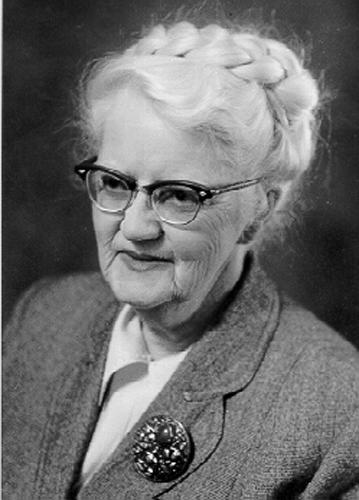
Mabel Timlin (1891–1976)
Department of Economics
Mabel Timlin, one of Canada’s most renowned economists, taught at USask for 24 years. Timlin’s Keynesian Economics (University of Toronto Press, 1942) was a foundational study in economics and Timlin went on to publish two highly regarded studies: Does Canada Need More People? (1951) and The Social Sciences in Canada (1968). The first woman social scientist elected to the Royal Society of Canada, she was awarded a fellowship by the Canada Council and in 1976 was named to the Order of Canada.
Source: "1921: Mabel Timlin." Deo et Patriae: Events in the History of the University of Saskatchewan (http://scaa.usask.ca/gallery/uofs_events). University of Saskatchewan, University Archives and Special Collections. Photo source: 1921a: Mabel Timlin. Photograph Collection, A-3256.
|
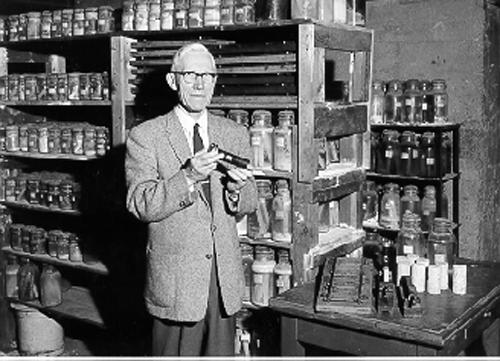
Thorbergur Thorvaldson (1883–1965)
Department of Chemistry
Thorbergur Thorvaldson altered the manufacturing of commercial cement and increased the durability of concrete structures through his research finding that alkaline ground water contained sulphates that were a direct cause of the deterioration of concrete structures. In 1952, USask President W.P. Thompson stated, “Many of the problems solved by his wide knowledge and experimental ability have been directly related to economic improvement, and the value of his researches could be computed in amounts considerably greater than have been spent on the construction and maintenance of the university during its entire history. He has built up a Department of Chemistry that has carried the fame of the university wherever his students have gone.”
Source: "1924: Thorbergur Thorvaldson." Deo et Patriae: Events in the History of the University of Saskatchewan.(http://scaa.usask.ca/gallery/uofs_events). University of Saskatchewan, University Archives and Special Collections.
Photo source: 1924b: Thorvaldson in cement testing lab, 1958. Photograph Collection, A-1640.
|
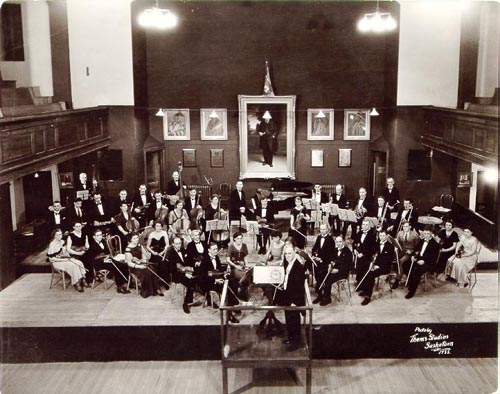
Arthur Collingwood (1880–1952)
Department of Music
Arthur Collingwood was appointed Music Chair when the Carnegie Corporation awarded USask a grant in 1931 to establish a School of Music, making it the first university west of Toronto to hold a Music Chair. Not only did Collingwood teach classes through the College of Arts and Science, but he was responsible for involving the university in the city’s cultural life. He did so by reorganizing the Saskatoon Symphony Orchestra and giving a series of public lectures.
Source: "1931: School of Music Established." Deo et Patriae: Events in the History of the University of Saskatchewan (http://scaa.usask.ca/gallery/uofs_events). University of Saskatchewan, University Archives and Special Collections.
Photo source: 1931b: Saskatoon Symphony, 1933. Photograph Collection, A-2941.
|
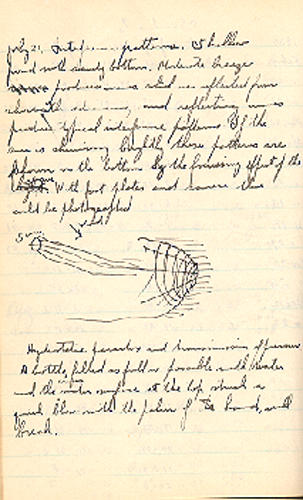
Balfour Currie (1902–1981)
Department of Physics
During the Second International Polar Year, 1932-1933, Balfour Currie, a professor of physics at USask, was stationed at Chesterfield Inlet in the Canadian Arctic while on leave from the university. Taking several thousand pictures of aurora, measuring electric fields and other meteorological variables while in the arctic, Currie returned home with few solid findings. However, the interpretation of these images in the years following inspired a generation of space and upper atmospheric scientists. “Currie’s contribution enabled Canada to participate actively in space science…That is the real legacy of Chesterfield Inlet and Balfour Currie.”
Source: "1933: Balfour Currie and the 2nd International Polar Year." Deo et Patriae: Events in the History of the University of Saskatchewan (http://scaa.usask.ca/gallery/uofs_events). University of Saskatchewan, University Archives and Special Collections.
Photo source: 1933a: Excerpt from Currie diary. W.O. Kupsch fonds, MG 146.
|
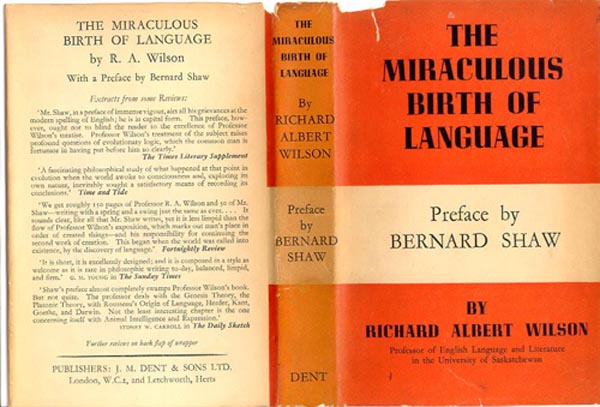 Richard Albert Wilson (1874–1949) Richard Albert Wilson (1874–1949)
Department of English
In 1937, USask Professor of English Richard Albert Wilson published The Birth of Language. It inspired Irish comic dramatist and literary critic George Bernard Shaw to create a second edition for which he wrote a preface. Shaw argued that Wilson’s literary work was “proof that the University of Saskatchewan was ‘apparently half a century ahead of Cambridge in science and of Oxford in common sense.’”
Source: "1937: The Miraculous Birth of Language.” Deo et Patriae: Events in the History of the University of Saskatchewan. (http://scaa.usask.ca/gallery/uofs_events). University of Saskatchewan, University Archives and Special Collections, 2002. Photo source: 1937b: dust cover, 1942 edition.
|
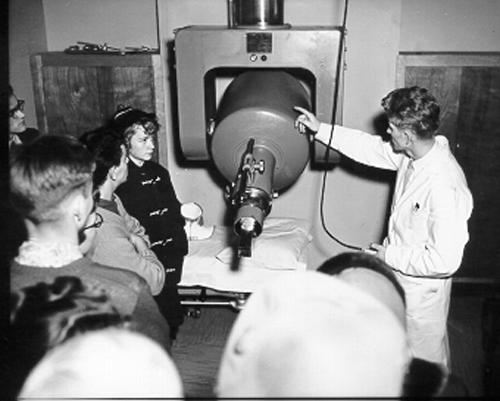 Harold Johns (1915–1998) and Cobalt-60 Harold Johns (1915–1998) and Cobalt-60
Department of Physics
Harold Johns, a professor in USask’s Department of Physics, designed the world’s first calibrated Cobalt-60 therapy unit in October 1951, changing cancer treatment worldwide. As a result of the machine, a complete set of isodose table became available to physicians and Johns’ X-ray dosage table is still used by doctors today. Furthering earlier research achievements in of the Department of Physics, the unit was instrumental in elevating Canada to a leader in the field of therapeutic radiology.
Source: "1951: Cobalt-60.” Deo et Patriae: Events in the History of the University of Saskatchewan (http://scaa.usask.ca/gallery/uofs_events). University of Saskatchewan, University Archives and Special Collections.
Photo source: 1951b: explanation of the cobalt-60 unit. Photograph Collection, A-3622.
|
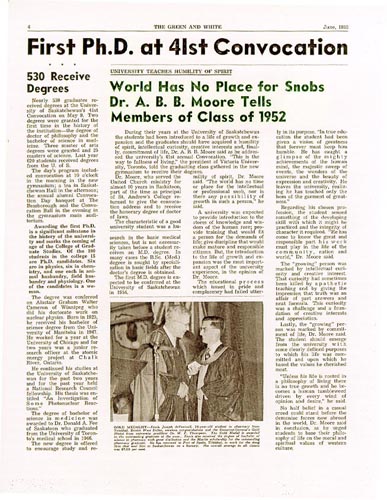 Alastair Graham Walter Cameron (1925–2005) Alastair Graham Walter Cameron (1925–2005)
Department of Physics
Alastair Graham Walter Cameron, a trailblazer in photonuclear reaction studies using the betatron, was awarded the University of Saskatchewan’s first PhD at Spring Convocation in 1952. In 2005, the American Physical Society honored Cameron “for his pioneering work in developing the fundamental concepts of nuclear astrophysics. These basic ideas, laid out almost 50 years ago, are still the basis of current research in this field."
Source: "1952: University of Saskatchewan Awarded its First Ph.D.” Deo et Patriae: Events in the History of the University of Saskatchewan (http://scaa.usask.ca/gallery/uofs_event). University of Saskatchewan, University Archives and Special Collections.
Photo source: 1952a: Green and White, Spring 1952.
|
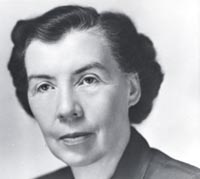 Hilda Neatby (1904–1975) Hilda Neatby (1904–1975)
Department of History
Professor of History Hilda Neatby published her influential work So Little for the Mind in 1953 and sparked a national discussion about Canadian education. The book, an analysis of the provincial educational system, was widely debated and challenged the existing structures of Canadian education. Neatby was a member of the Massey Commission (1949–1951) which reviewed the state of learning and culture in Canada and led to the creation of the Canada Council.
Source: "1953: Hilda Neatby’s So Little for the Mind Published.” Deo et Patriae: Events in the History of the University of Saskatchewan (http://scaa.usask.ca/gallery/uofs_events). University of Saskatchewan, University Archives and Special Collections.
Photo Source: 1953a: Hilda Neatby. Photograph Collection, A-3321.
|
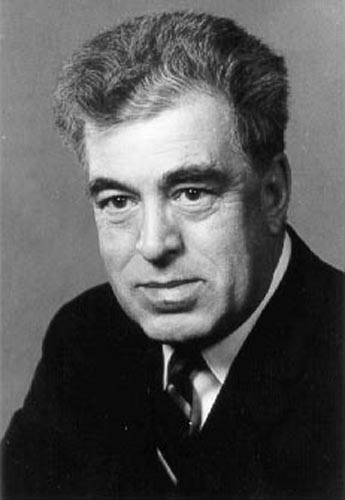 Constantine Henry Andrusyshen (1907–1983) Constantine Henry Andrusyshen (1907–1983)
Department of Slavic Studies
In 1955 Constantine Henry Andrusyshen, head of the Department of Slavic Studies, published his extensive Ukrainian-English Dictionary. It contained a summary of Ukrainian grammar, approximately 100,000 word entries and 35,000 idiomatic expressions. Republished in 1957 and 1981, it is still recognized today as an outstanding work among Ukrainian lexicographers. Andrusyshen’s legacy at USask continues today for his contributions as a linguist, translator, teacher and lexicographer.
Source: "1955: Andrusyshen Publishes Ukrainian-English Dictionary.” Deo et Patriae: Events in the History of the University of Saskatchewan (http://scaa.usask.ca/gallery/uofs_events). University of Saskatchewan, University Archives and Special Collections. Photo Sources: 1955a: V.O. Buyniak fonds, MG 134, VI. A., 1956-1991.
|
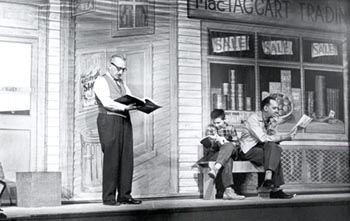 Greystone Theatre Greystone Theatre
Department of Drama
In 1959 the Greystone Theatre presented the world premiere of Royalty is Royalty, W.O. Mitchell’s first stage play loosely based on his popular CBC radio series Jake and the Kid. This project was part of an initiative by the Department of Drama, Canada’s and the Commonwealth’s oldest degree-granting drama department, to produce a new Canadian play annually. Unique to this project was the attendance and participation of the author in all rehearsals and performances of the play to re-write the piece as the author saw and heard the production. This process not only benefited the students who were given the chance to perform Canadian plays, but also the authors who were given a chance to perfect their work.
Source: "1959: Greystone Presents World Premiere of W.O. Mitchell Play.” Deo et Patriae: Events in the History of the University of Saskatchewan (http://scaa.usask.ca/gallery/uofs_events). University of Saskatchewan, University Archives and Special Collections.
Photo Source: 1959b: Scene from the production. Department of Drama fonds, RG 2036, file C51; Western Producer photo.
|
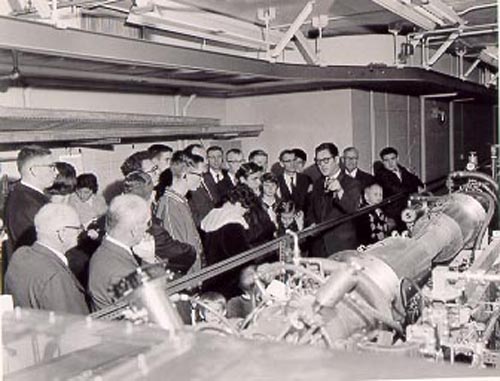 Linear Accelerator Linear Accelerator
Department of Physics
In the progression of technological advance for the Department of Physics, following the betatron and the Cobalt-60 therapy unit, USask opened the Linear Accelerator in 1964 which created six times more energy than the betatron, a particle accelerator that the department previously used. Physicists from around the world have used the facility, which has brought international recognition to USask's research.
Source: "1964: Linear Accelerator Opens.” Deo et Patriae: Events in the History of the University of Saskatchewan (http://scaa.usask.ca/gallery/uofs_events). University of Saskatchewan, University Archives and Special Collections.
Photo Source: 1964a: Linear Accelerator–Laboratory, Nov 1964, Photograph Collection, A-8643.
|
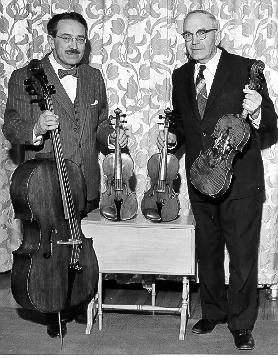 Amati Instruments Amati Instruments
Department of Music
In 1959, USask acquired a set of rare 17th-century Amati string instruments (two violins, a viola and a cello) from collector and farmer Steve Kolbinson with the understanding that the instruments be used for the benefit of the people of Saskatchewan. Built by the Amati family between 1607 and 1690, the instruments are the only ones in Canada and are one of the few remaining sets in the world.
Source: "1969: Amati Quartet Makes its Debut .” Deo et Patriae: Events in the History of the University of Saskatchewan (http://scaa.usask.ca/gallery/uofs_events). University of Saskatchewan, University Archives and Special Collections.
Photo Source: 1969b: Murray Adaskin and Steve Kolbinson. Photograph Collection, A-2669.
|
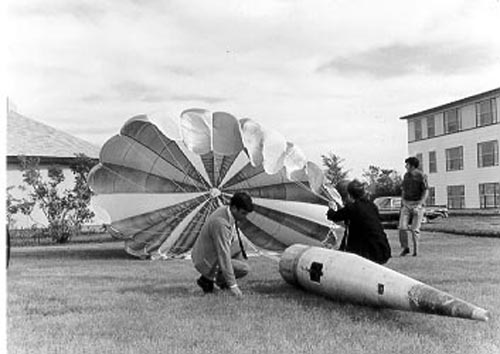 Space Engineering Division Space Engineering Division
Institute of Space and Atmospheric Studies
In 1965, USask's Institute of Space and Atmospheric Studies announced the formation of the Space Engineering Division (SED) to design and construct rocket instrumentation for upper atmospheric testing. In 1972, SED delivered the ground control system for the first Canadian Communications Technology Satellite. In 1998, after becoming a private company, SED won the largest contract ever awarded by the European Space Agency to a Canadian organization for a 35-meter deep-space antenna system. SED is now a leader in satellite technology systems.
Source: "1976: SED at the Saskatoon Airport .” Deo et Patriae: Events in the History of the University of Saskatchewan (http://scaa.usask.ca/gallery/uofs_events). University of Saskatchewan, University Archives and Special Collections.
Ralko, Joe. “Space Engineering Division (SED).” Encyclopedia of Saskatchewan.( http://esask.uregina.ca/entry/space_engineering_division_sed.html). Canadian Plains Research Center, 2006.
See also http://www.sedsystems.ca/history
Photo source: 1976b: SED–Payload recovery, Sep 1969, Photograph Collection, A-8647.
|
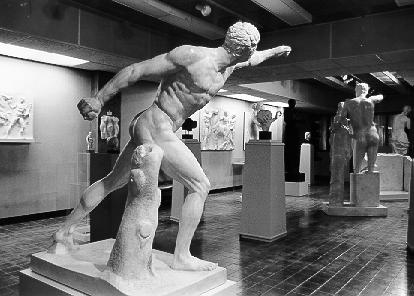 Museum of Antiquities Museum of Antiquities
In 1981, the Museum of Antiquities opened in the Main Library at the University of Saskatchewan. The museum is the only one of its kind at a Canadian university, enriching the experience of art, history and classics students by exhibiting reproductions onsite from the British Museum in London, the Louvre in Paris, the Acropolis Museum in Athens and the Museum of Antiquities in Delphi, among others, and supporting research into classical artifacts. The idea of the museum was initiated by professors Nicholas Gyenes (1911–1984) of the Department of Art and Art History and Michael Swan (1931–2021) of the Department of History. The museum has since acquired a number of original artifacts and works of art, including a bronze bust of Hannibal that is believed to have once belonged to Emperor Napoleon Bonaparte.
Source: "1981: Museum of Antiquities Opens .” Deo et Patriae: Events in the History of the University of Saskatchewan (http://scaa.usask.ca/gallery/uofs_events). University of Saskatchewan, University Archives and Special Collections.
Photo source: 1981a: Museum of Antiquities. Photograph Collection, A-8788.
|
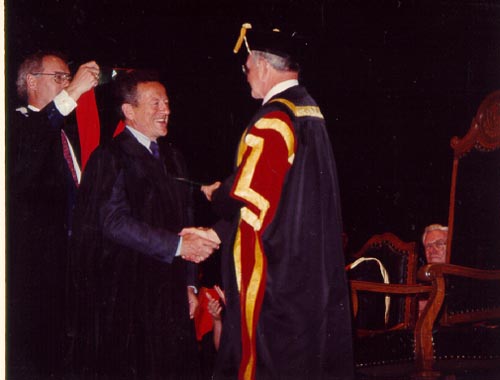 Eli Bornstein Eli Bornstein
Department of Art and Art History
“Through the excellence and originality of his art Eli Bornstein has earned himself a singular place in the history of Canadian art” (Fenton, 1996). Both as an artist and as a teacher, Bornstein has influenced the Canadian art scene since 1950 through his abstract constructed reliefs, through his founding and editing of the international art journal The Structurist, and through his teaching which has influenced generations of USask students.
Sources: Fenton, Terry. “Art Toward Nature.” (Exhibition Catalogue). Mendal Art Gallery, 1996.
"1990: Eli Bornstein Honoured .” Deo et Patriae: Events in the History of the University of Saskatchewan (http://scaa.usask.ca/gallery/uofs_events). University of Saskatchewan, University Archives and Special Collections.
Photo source: 1990a: Eli Bornstein receiving honorary degree. Photograph Collection, A-7963.
|
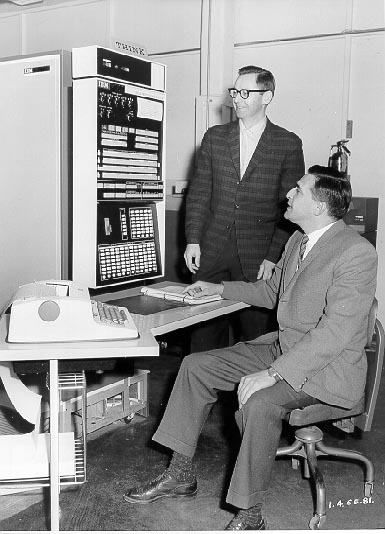 Department of Computer Science Department of Computer Science
USask was one of the first universities in Canada to obtain a computer—an LGP-30, which was a joint purchase between the university and the National Research Council’s Prairie Research Laboratory in 1960. Used to support research in the Department of Computer Science, the computer also bolstered teaching within the department. Three decades after being established at USask, the Department of Computer Science was cited more frequently per paper than any other computer science department across the country in a research impact study.
Source: "1996: Computer Science First in Research .” Deo et Patriae: Events in the History of the University of Saskatchewan (http://scaa.usask.ca/gallery/uofs_events). University of Saskatchewan, University Archives and Special Collections.
Photo Source: 1996a: ‘Computation centre,’ 1966. Photograph Collection, A-1873.
|
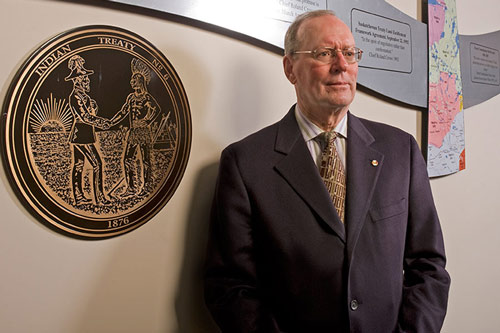 James R. Miller James R. Miller
Department of History
In his career spanning more than four decades, USask historian James Miller became widely regarded as Canada’s leading expert in the field of Indigenous-newcomer relations. In 1989, he authored Skyscrapers Hide the Heavens, the first comprehensive history of this relationship in Canada. He earned respect as a consultant to both government and First Nations organizations on treaty and residential school issues. For his lifetime of contributions—including his critical role in bringing to light the history of Canada’s residential schools—Miller was awarded the 2014 Killam Prize in the Humanities, one of Canada’s most distinguished awards for scholars.
|




 Richard Albert Wilson (1874–1949)
Richard Albert Wilson (1874–1949) Harold Johns (1915–1998) and Cobalt-60
Harold Johns (1915–1998) and Cobalt-60 Alastair Graham Walter Cameron (1925–2005)
Alastair Graham Walter Cameron (1925–2005) Hilda Neatby (1904–1975)
Hilda Neatby (1904–1975) Constantine Henry Andrusyshen (1907–1983)
Constantine Henry Andrusyshen (1907–1983) Greystone Theatre
Greystone Theatre Linear Accelerator
Linear Accelerator Amati Instruments
Amati Instruments Space Engineering Division
Space Engineering Division Museum of Antiquities
Museum of Antiquities Eli Bornstein
Eli Bornstein Department of Computer Science
Department of Computer Science James R. Miller
James R. Miller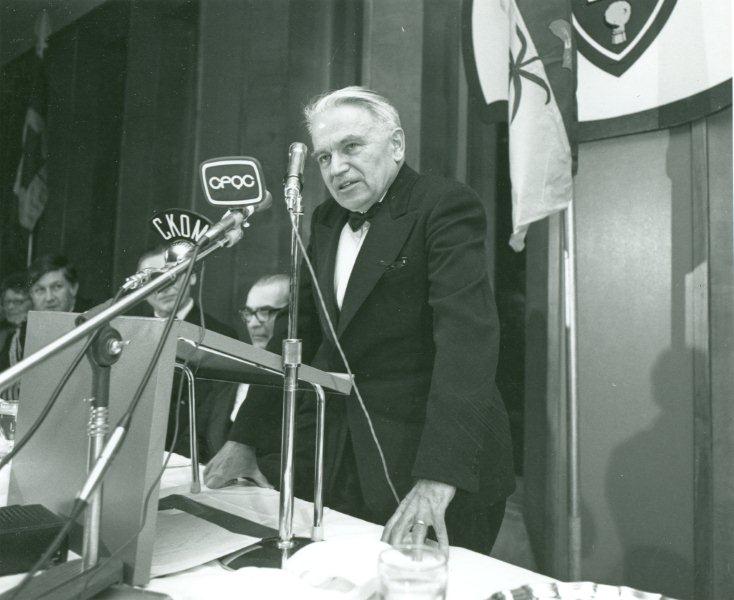 Gerhard Herzberg (1904–1999)
Gerhard Herzberg (1904–1999)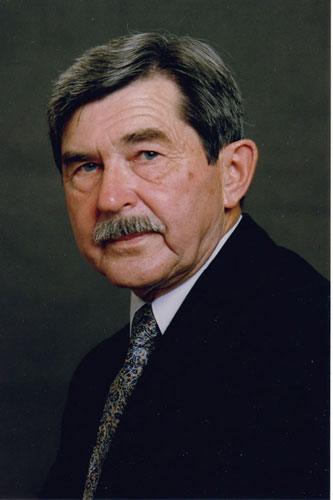 Henry Taube (1915–2005)
Henry Taube (1915–2005)